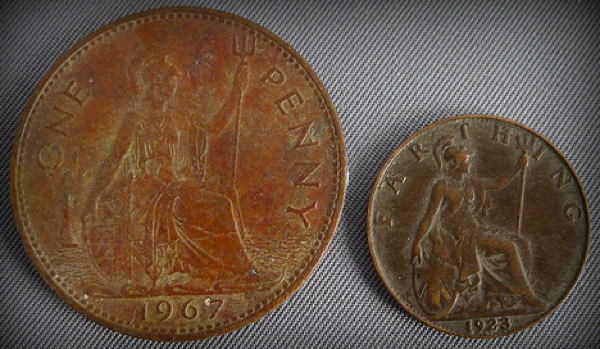Yes, but I was thinking more of the physical coins.

Yes, but I was thinking more of the physical coins.

Right.
The sizes don’t reflect the value felt.
As a kid. I always felt the 3 pence coin, the Thruppence Bit, was worth a lot more than 12 Farthings … of course it wasn’t …
I’ve seen the explanations of British currency values many times, but it never really sinks in. When I read something that uses it, I have only the vaguest sense of the worth and relationships. “Wait, how many guineas in a sovereign?!”
That’s because the entire country was using l.s.d… or pounds shillings and pence.
From
https://www.retrowow.co.uk/retro_britain/old_money/origins_of_lsd.html
The reason we used ‘d’ for pence is that ‘d’ stood for denarius. Of course ‘s’ can stand for shilling or solidus and ‘l’ stands for ‘libra’, the Roman pound. So 12 denarii (‘d’) made one solidus (‘s’) and twenty solidii made one pound (‘l’).
Very true of the time. Also LSD* was in common circulation. 
In decimal: 0.9523809524
In l.s.d. thinking: 20 21st’s is the sovereign portion of the guinea
Following the 1816 - Great Recoinage a Sovereign Coin was fixed to equate to 1 Pound (£1 Sterling) that contained 123.2745 grains of gold (22 carat).
BTW, " The basic unit of currency in medieval England was the silver penny or Sterling, weighing about 1⁄240 of a tower pound."
I am very glad @CodaCoder is showing the Great Brain of the @Mark_S …
Back in the day @Mark_S solved a difficult social-maths issue for me converting between Papua New Guinea OKSAPMIN Countiing (base-27) and decimal and back.
Result …
See: Google Group: Number Base Conversion Macro (2019)
I’m pretty sure I never saw that diagram.
There are memory systems based on body parts. Like a portable memory palace. This seems similar. Was there a taboo against using the lower parts, I wonder? You could triple your counting base, in possibly amusing ways.
That is a shame. It was supposed to be a kinda tx.
Plausibly. But also I’d say it’s plausible you’d avoid them for simple convenience - not as much can be reached easily, and if sitting (making more reachable) then what’s visible and relative positions of body parts change. Would the extra complications be worth it?
@nemo as part of the Sitting Generation I agree the unmentionables have a lacklustre confinement.
Prior to The Chair it was different.
That is a shame. It was supposed to be a kinda tx.
Oh, you’re right. I left the memory on the wrong elbow.
I have strong suspicions that people have been sitting since before the invention of walking upright (which, to be fair I wasn’t there, but I suspect predates the invention of the chair by at least four days)
people have been sitting since before the invention of walking upright
In The Squat (sitting before chairs) the unmentionables are less constrained.
Back to the old currencies. In retrospect they look absolutely rediculose, and hevens knows I am glad I live in a world of Decimal coinage and meters/kilometers.
Howevwer I did discover something all by myself decades ago. I was studying the primes, and was looking at the numbers near them, and wrote a program to identify the opposites, numbers with a high divisibility. What popped out was all these numbers we see in many places and wonder why they were chosen?.
To put it this way many of these divisions between currencies, or compas directions, hours, and Minutes allow for comon divisions. For example bread roles were often sold in the dozens because it could be divided into lots of 1, 2, 3, 4, or 6. And yes the bakers dozen 13 was to ensure if one role was no good they still had 12 to sell. A bit like a check digit.
This is quite interesting when you look into it, not to mention primes, which is an obsession of mine. Now thats another story.
And for another miscellaneous fact from arithmetic, the number of milliseconds in a day is
11 × 22 × 33 × 44 × 55
which for some strange reason, I find to be delightful.